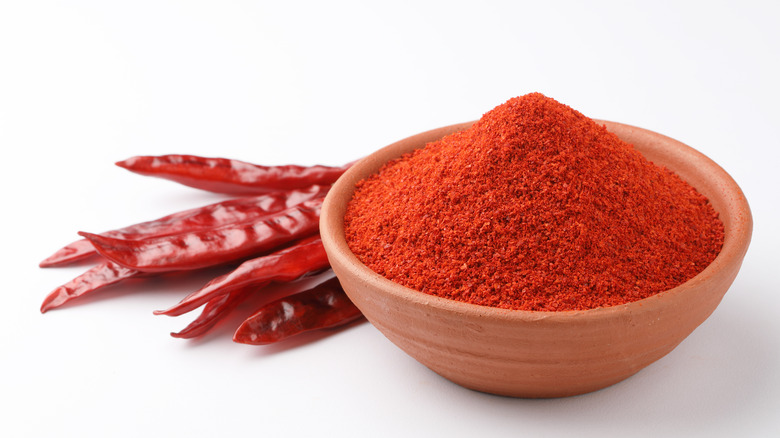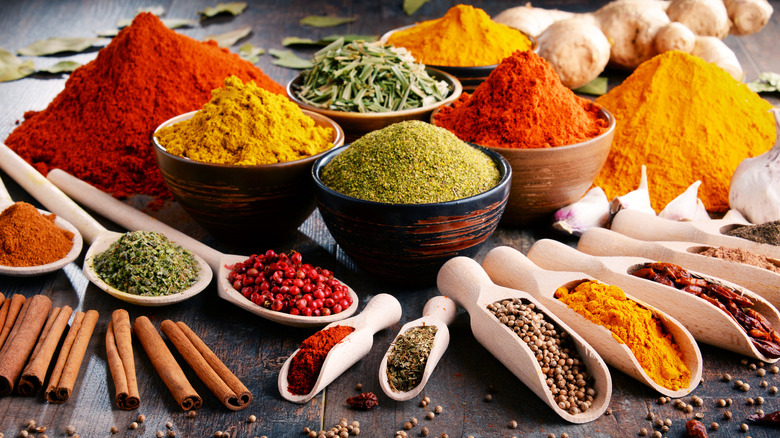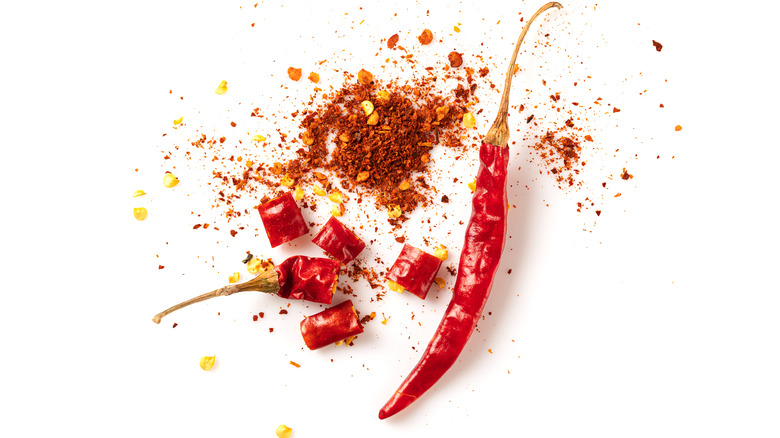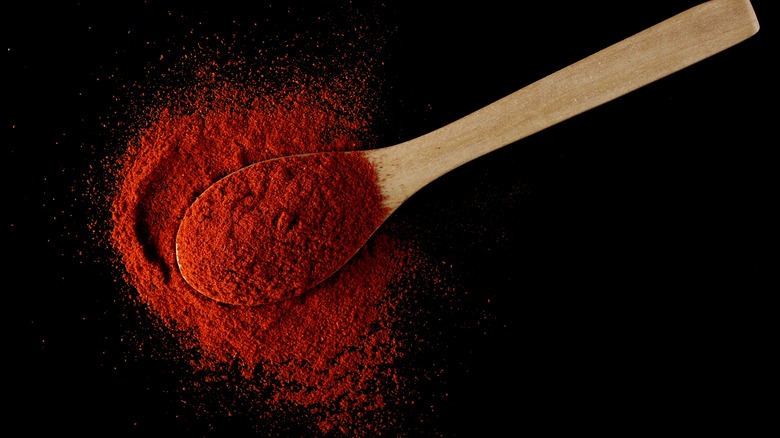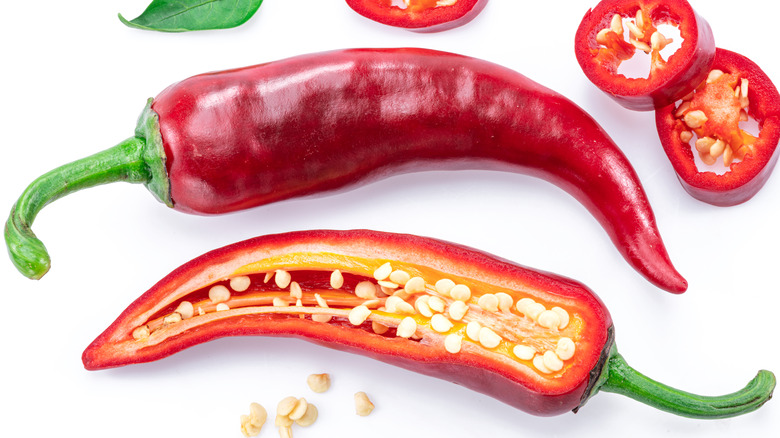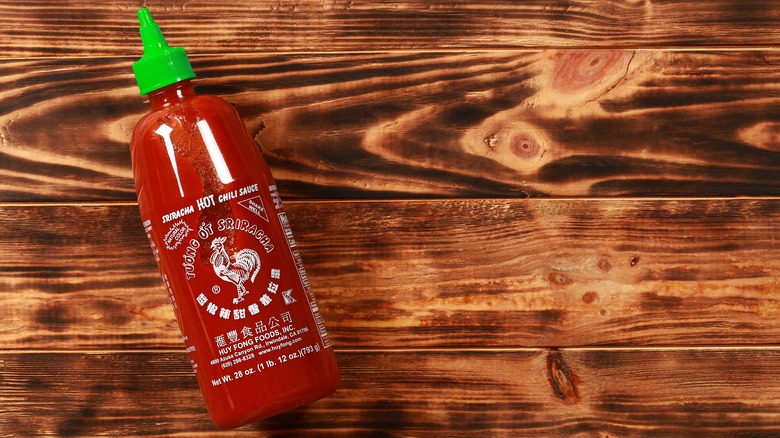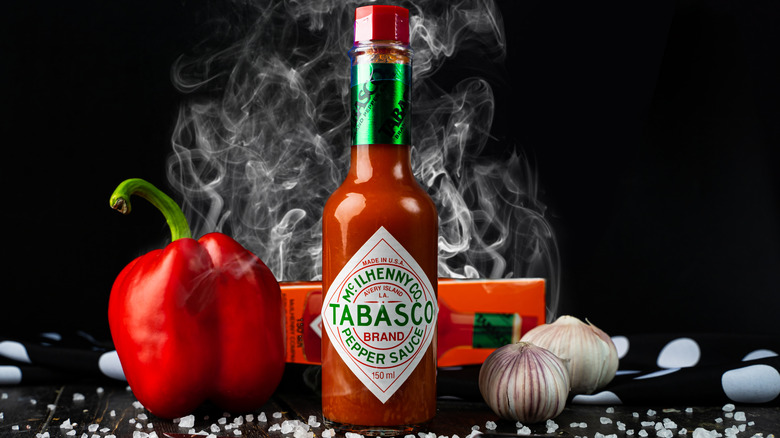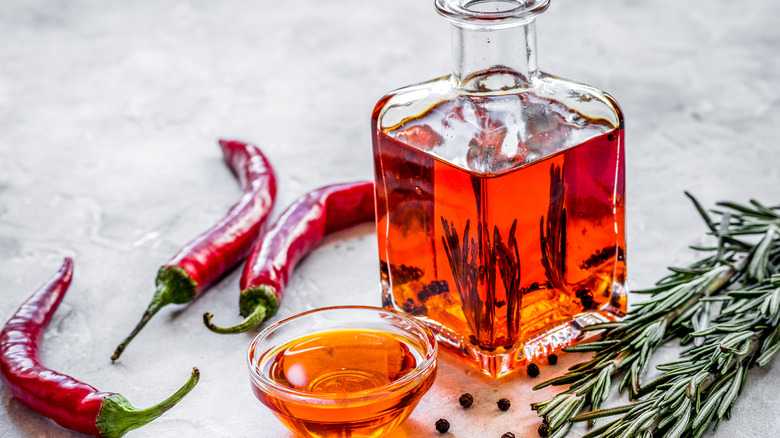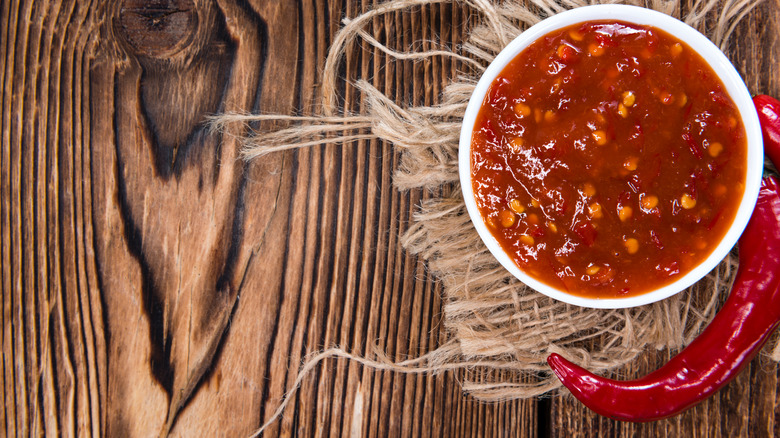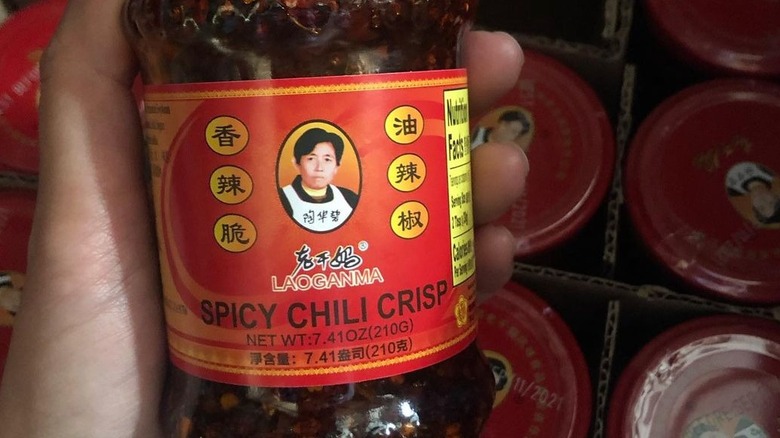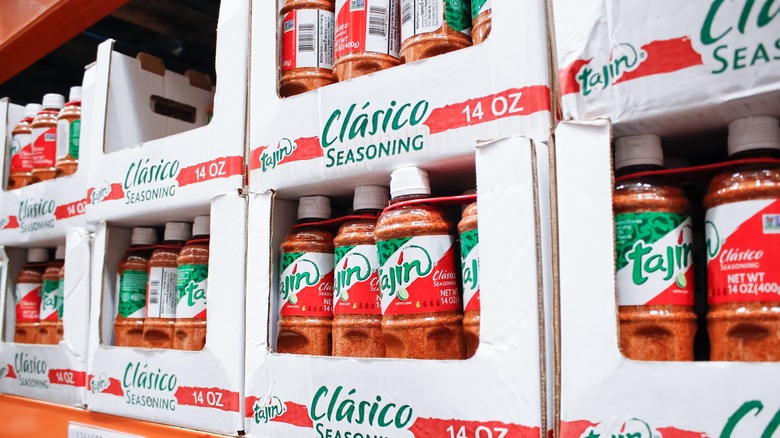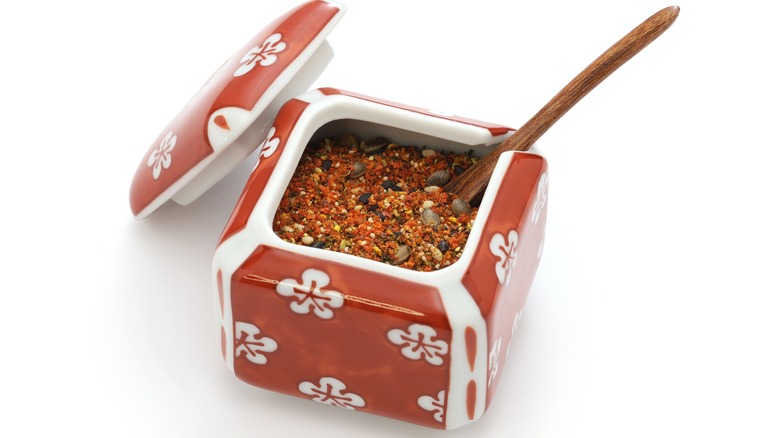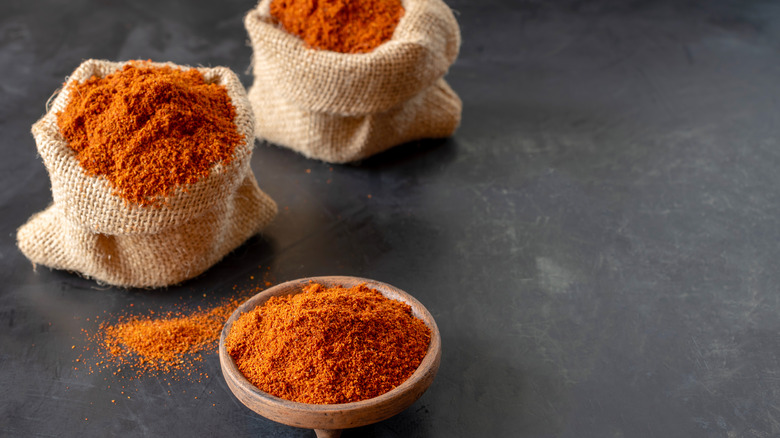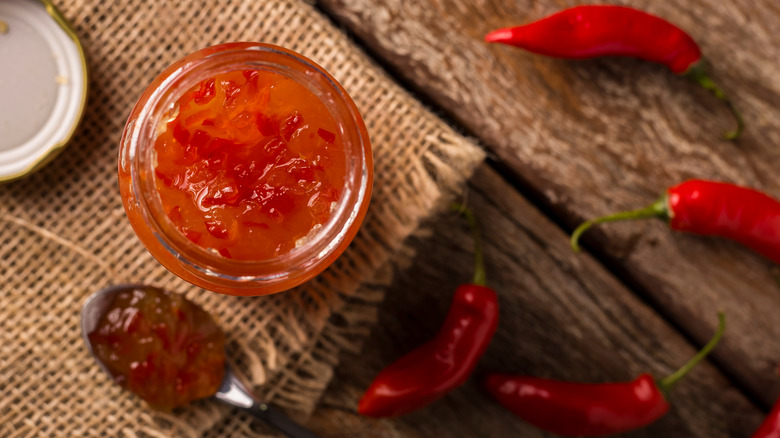14 Alternatives For Chili Powder
While credit for inventing chili powder is hotly contested, there's no arguing that this Tex-Mex spice blend is a staple in most American pantries. If you are currently in the middle of a recipe and just realized that you don't have enough chili powder, fear not; there are several capable alternatives.
Everyone seems to agree that chili powder was invented in Texas, but the consensus on who invented chili powder seems to be divided between two individuals: German immigrant William Gebhardt and a Cincinnati carpetbagger of some renown DeWitt Pendery (via D Magazine). While it's established that Gebhardt was grinding dried chilies and selling them in 1869, Pendery had been marketing a chili blend in the Dallas-Fort Worth area by 1890.
Today, chili powder from major brands like McCormick is available in almost every supermarket. While spice blends can differ, chili powder is typically made from similar blends of dried chilies and spices. Store-bought chili powder adds a signature Tex-Mex flavor profile to any dish, but several capable alternatives can serve the same or a slightly similar function.
You can make your own
Chili powder from McCormick is arguably the most ubiquitous, and if you've run out of chili powder, the company is kind enough to provide a recipe on its official website. Simply blend equal parts of cumin, paprika, oregano, and garlic powder. Then, add a dash of ground-dried chilies.
The type of ground chilies that you add can affect the flavor profile of the resulting chili powder. For example, add a dash of cayenne powder if you want a conventional flavor profile. However, you can add a dash of ground chipotle pepper if you want something a little smoky and more contemporary.
If you're going to go through the trouble of making your own chili powder, you may want to consider kicking it up a notch by going beyond store-bought spices. Any fresh oregano in your garden? Add it to your spice blend to bring some serious freshness to the party. And, if you have access to whole spices and dried chilies, toasting them and then grinding them up can add a level of vibrancy you can't get from store-bought herbs. When going the fresh route, be sure to add your spice blend conservatively and taste your recipe as you go.
Cayenne is pretty darn close
Native to South America and brought back to Europe by Christopher Columbus, cayenne peppers are the main ingredient in chili powder (via Sonoran Spice Blog). These thin red peppers are moderately hot and can be found in a wide range of cuisines, including Tex-Mex, South American, Creole, and various Asian cuisines.
Because cayenne is the predominant ingredient in conventional chili powder, it functions as a great substitute. Ground cayenne pepper is typically marketed as cayenne, but it's also sometimes labeled as ground red pepper. Home cooks can use these two spices interchangeably. Cayenne should be employed in smaller amounts when being used as a chili powder substitute, as chili powder only contains a small fraction of this powerful spice. If cayenne is used as a one-for-one substitute, it can result in a dish being much hotter than intended. Also, some chili powders have a blend of dried peppers; therefore, only using cayenne could result in a slightly less-nuanced peppery taste. Including a bit of garlic powder, oregano, cumin, and/or paprika can round out the flavor profile, bringing it much closer to that of chili powder.
Use chili pepper powder
Chili powder and chili pepper powder may seem like different names for the same thing, but they are, in fact, two different things (via Southern Living). While the latter can be used as a substitute for the former, it should not be treated as a like-for-like swap. The standard chili powder uses a base of cayenne pepper and paprika, but chili pepper powders are singular varieties of dried and ground peppers.
Each type of pepper powder can bring something different as a chili powder substitute. Ground chile de árbol brings spice and heat, strongly resembling ground cayenne. Chipotle chili powder can add smokiness and a bit of earthiness. Ancho chili powder delivers a slightly fruity flavor profile. Because chili powder only includes a small portion of actual dried pepper, ground ancho, chipotle or other peppers should be used in smaller amounts. Rounding out these dried chilies with other chili powder ingredients like oregano and cumin can get you closer to achieving a true replacement.
Sprinkle in some paprika
Since paprika is used to make chili powder, it can also be a substitute for it. If you are wondering, "Is paprika spicy?" — well, it can be, depending on the type. Made from red peppers in the nightshade family Capsicum annuum, there are three different kinds of paprika: sweet, smoked, and hot.
The standard paprika found in the grocery store is typically the sweet variety. It has a warm, barely sweet taste. If you are looking to use this as a chili powder alternative, it would help to add a bit of heat along with the paprika. As the name indicates, smoked paprika is essentially sweet paprika that has been dried using smoke. As a chili powder alternative it can add a bit of smokiness that lends itself to Tex-Mex flavors. Adding a bit of heat alongside smoked paprika will also result in a more well-rounded replacement. Hot paprika, also called hot Hungarian paprika, per BBC Good Food, is similar to sweet paprika except it is made with spicier Capsicum annuum peppers. Because it brings both earthiness and some spiciness, it is probably the most well-rounded paprika alternative for chili powder.
Use fresh red chilies
There are many different types of chilies out there, and if you're looking for a chili powder substitute, you should know that it is made with red chilies. Therefore, fresh red chilies will be a better alternative than green chilies, with their more pronounced flavor profile (via the Guardian). Fresno chilies are a relatively mild type of red chilies that can typically be found fresh or in cans. Hungarian wax peppers are similar to jalapeños, but these peppers will turn red if they ripen. Fresh cayenne or chilies de árbol are difficult to find, but they are two of the best peppers to use as chili powder substitutes. Chilies de árbol have slightly acidic notes that play well with tomato sauces or salsas.
Of course, you could always use hot chilies like Thai or Scotch bonnet chilies. However, these are much hotter than the chilies found in chili powder. So unless you're really looking to dial up the heat, you only need a little bit when using them as a chili powder substitute.
Squeeze on some sriracha
Invented in Thailand and popularized in the U.S. by Huy Fong Foods, sriracha is a spicy condiment that can add heat to any dish. As a chili powder alternative, sriracha adds the right amount of heat and spice. However, including garlic and other aromatics gives it a strong Asian flavor profile. As a result, it can skew dishes away from an intended Tex-Mex target.
The iconic sriracha from Huy Fong Foods was inspired by a Thai sauce called Sriraja Panich. The original sauce has a thinner consistency, and it undergoes a three-month fermentation process. The American sriracha from Huy Fong is spicier, and people from Thailand say it is overpowering compared to the original (via Bangkok Post).
The untold truth about sriracha includes the fact that Huy Fong founder David Tran never trademarked the name. As a result, the word "sriracha" appears on countless products, including knock-off varieties of the sauce from massive brands like Kikkoman, Frank's Red Hot, and Lee Kum Kee. Considered a niche condiment slightly more than a decade ago, we can now find sriracha in desserts, popcorn, and even craft beer.
Add heat with some Tabasco
Made with its namesake chilies, Tabasco sauce is capable of bringing a level of heat similar to that of chili powder. Tabasco is also made from salt and vinegar. Higher levels of salinity and acidity should be considered when using Tabasco as a replacement for chili powder. Additionally, Tabasco does not bring any herbal notes to the party, making chili powder herbs like oregano or cumin welcome additions to this potential replacement.
Tabasco sauce was originally meant to be sprinkled on food, and its inventor Edmund McIlhenny marketed it by using a bottle similar in shape to those used for cologne. The caps on these original bottles were called "sprinkler fitments," and they were engineered to dispense single drops or dashes of the sauce. The reasoning was that Tabasco sauce is so concentrated that only a few drops are necessary. The sprinkler fitment tops were covered with removable green wax to keep the sauce from leaking out before being purchased. In 1927, the company ditched the original tops in favor of red twist-off caps.
Consider chili oil
Soy sauce might be the condiment that we most associate with Chinese food, but chili oil is just as prevalent in kitchen pantries across China. Made by infusing a neutral oil with dried and or fresh chilies, chili oil can be used to add both heat and fat to any dish.
Although it may be of Asian origin, chili oil can be a viable replacement for chili powder. In fact, various chili oils can be found in dishes from Korea to Italy to Mexico. While you are most likely to find useful chili oil in the Asian section of your local supermarket, different types of chili oil can be found in Italian or Mexican sections as well.
Making this chili powder alternative at home is fairly simple, especially if you have a good chili oil recipe. In a small saucepan, combine one cup of neutral oil with seven moderately hot chilies, too clove of garlic, a teaspoon of paprika, and a pinch of salt. Bring the ingredients to a low simmer and keep them there for 10 minutes. Then turn off the heat and allow your chili oil to stand for 30 minutes before straining to remove the solids.
Add flair with sambal oelek
California-based Huy Fong Foods is probably best known for its ubiquitous sriracha sauce, but the company also makes a spicy chili paste called sambal oelek, which could easily be used as a chili powder substitute. So, what is sambal oelek, really, and what does it taste like?
Sambal is an Indonesian hot sauce made by mashing chilies into a paste. Given that Huy Foods was founded by a Vietnamese immigrant to America, it makes sense that the company's version deviates slightly from the traditional Indonesian variety: It is made from jalapeño seeds and includes a bit of vinegar and salt. When added to a dish, sambal oelek has a similar effect to using fresh chilies.
If you are looking to use sambal oelek as a replacement for chili powder, you should add it conservatively and be mindful of this ingredient's Asian flavor profile. Cumin is a natural pairing with sambal oelek, and using it can make this chili paste an even better alternative to chili powder.
Go with the trendiest alternative: chili crisp
As a fan of food blogs, you, dear reader, likely know that chili crisp is one of the trendiest condiments on the Internet these days. But maybe you always wondered to yourself: What is chili crisp, and how do you use it? Also, how does it work as a chili powder alternative? There are many different kinds of chili crisp, but almost all of them include crushed chili peppers, garlic, onions, and spices packed in oil. The resulting condiment is spicy, oily, and crunchy in texture. That blend of heat, fat, and consistency has won chili crisp a legion of followers in recent years, including one John Cena (via Mothership).
Compared to chili powder, and like John Cena, chili crisp is pretty extra. However, that added element of texture only means that you need to be judicious when using it as a chili powder substitute. Hard shell tacos and other crunchy dishes will absolutely benefit from the addition of chili crisp, while dishes that are meant to be smooth or chewy probably won't be a good match.
Tajin seasoning is more Mex than Tex
Chili powder may be a ubiquitous spice blend, but spice blends from Tajin are also strongly associated with Tex-Mex cooking. So, what is Tajin seasoning, and what does it taste like? The most popular Tajin Clásico blend imparts acid and mild heat through a combination of dried peppers, salt, and dehydrated lime juice. As a chili powder replacement, it can bring similar heat and a bit of spice. The addition of lime is a natural one and should fit well in most Tex-Mex recipes.
It's important to note that uses for Tajin go far beyond acting as an ingredient in Tex-Mex cooking. Famously, it adds a lot of complexity and a bit of heat to fresh fruits like watermelons, mangoes, and pineapples. Tajin is also famously used in salt rims on glasses for alcoholic drinks like margaritas and micheladas. In a pinch, it can also be used on its own as a dry rub for grilling beef, pork, or poultry.
Togarashi is Japan's answer to chili powder
Often associated with subtle and simple flavors, Japanese food is not typically celebrated for its use of spice. However, there is at one major exception: Togarashi is a key spice blend for bold and flavorful food.
Formally known as shichimi togarashi, this Japanese spice mixture is made from citrus peels, nori, poppy seeds, sesame seeds, ground red pepper, sansho pepper, and ground ginger. One excellent use for togarashi is adding heat and complexity to teriyaki. The spice blend pairs naturally with the traditional teriyaki dressing of soy sauce, rice wine, and sugar — giving the dish added dimensions of warmth and spice.
Togarashi is just as versatile a space blend as chili powder and quite similar. In fact, 'togarashi' is the Japanese word for peppers from the Capsicum annuum family, the same family from which chili powder is made (via Japanese Food Guide). That being said, togarashi imparts different shades of flavor wherever you add it. Additionally, the Japanese spice blend brings a bit of umami and hints of citrus, which wouldn't be out of place in most Tex-Mex dishes.
Add African flavor with berbere
Just as chili powder is the signature spice blend for Tex-Mex food, berbere is the signature blend for Ethiopian food. Until the global supply chain — and let's face it, Amazon — allowed us to access a cornucopia of global ingredients, berbere was hard to come by in the United States. But now, this spice blend pops up everywhere, and it's been embraced by celebrity chefs. For instance, Marcus Samuelsson's berbere recipe is a secret weapon that has led to award-winning restaurants all over New York City. It can give you the same success in your own kitchen.
Made from allspice berries, black peppercorns, cardamom, close, coriander, onion powder, and chili flakes — berbere has the requisite spice, heat, and umami of any good blend. This makes it a useful alternative for chili powder. But like every good spice combination, berbere can evoke a sense of place, and Samuelsson has said the mixture specifically represents Ethiopian terroir. As such, this chili powder alternative should be used when African influence is the intended flavor profile.
Use pepper jelly for some sweet heat
If you've never heard of pepper jelly before, you probably aren't a Southerner. Below the Mason-Dixon Line, pepper jelly is used as a spread, basting liquid, dessert component, and sauce ingredient. It can bring heat, acid, and sweetness to any dish, making it a potential substitute for chili powder in dishes where a bit of saccharine suppleness is not a bad thing.
Pepper jelly is fairly popular, and jarred versions are available in most supermarkets, especially those down South. if you can't seem to find pepper jelly in your store, you can always make it from scratch. If you are looking to make a chili pepper alternative, it's best to go with a hot pepper jelly recipe. Simply add jalapeño, poblano peppers, and red bell pepper to a blender along with a cup of apple cider vinegar. Pulse blend until the peppers are finely chopped, and transfer the mixture to a saucepan with salt and sugar. Heat the mixture until the sugar fully dissolves, and add a tablespoon of pectin. Cook until the pectin is completely incorporated, then allow cooling.
